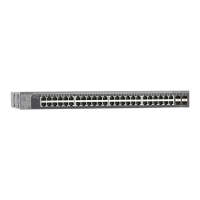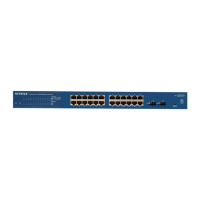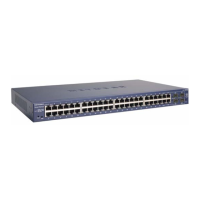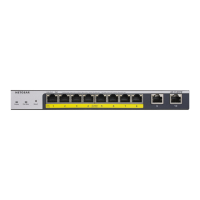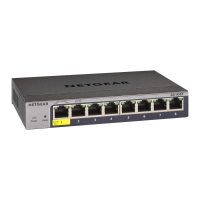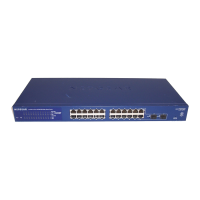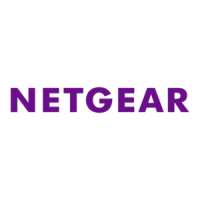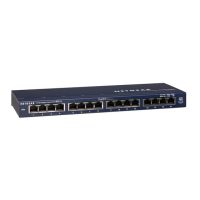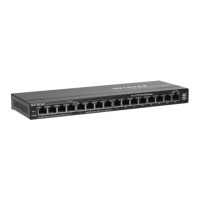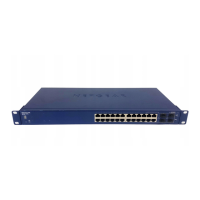
Do you have a question about the NETGEAR S350 Series and is the answer not in the manual?
Lists the available guides for the NETGEAR product.
Overview of switch management options and initial discovery tools.
Methods to change the switch's default IP address for remote management.
Methods to discover and change the switch's IP address.
Description of the available user interfaces for switch management.
Instructions on how to access the switch's local browser interface.
Explanation of the local browser interface navigation elements.
Steps to change the display language of the local browser interface.
Guide to using the Device View for navigating configuration and monitoring.
Description of physical and logical interface naming conventions.
Instructions for configuring interface settings for single or multiple ports/LAGs.
Information on accessing online help and the NETGEAR support website.
Instructions for accessing the user manual online.
Encouragement and instructions for registering the product.
How to display switch status and configure basic information like IP, clock, and DNS.
Monitoring CPU, memory resources, and utilization patterns for performance assessment.
Configuring network information for the local browser interface.
Setting the system date and time manually or via SNTP.
Configuring SNMP settings for SNMPv1/v2 and SNMPv3.
Configuring Link Layer Discovery Protocol (LLDP) for network capabilities advertisement.
Configuring DHCP snooping for security by filtering untrusted DHCP messages.
Defining multiple timer schedules for PoE power delivery to attached PDs.
Viewing and configuring physical port information and maximum frame size.
Combining multiple full-duplex Ethernet links into a single logical link.
Adding virtual LANs (VLANs) to segment the network and manage traffic.
Enabling Auto-VoIP for prioritizing voice traffic based on call-control protocols or OUI bits.
Configuring Spanning Tree Protocol (STP) for network loop elimination.
Managing multicast traffic forwarding and IGMP snooping settings.
Enabling and configuring loop protection per port or globally.
Understanding Quality of Service (QoS) for predictable data delivery.
Configuring Class of Service (CoS) queueing features for network traffic.
Configuring Differentiated Services (DiffServ) for traffic classification and priority.
Configuring login password, RADIUS, TACACS+, and authentication lists.
Configuring HTTP and HTTPS access to the switch's local browser interface.
Configuring global and per-port 802.1X access control settings.
Configuring MAC filters, storm control, and port security settings.
Creating and applying access control lists (ACLs) to manage network resource access.
Viewing traffic information transmitted and received on the switch and its ports.
Managing memory, flash, and server logs for system monitoring and troubleshooting.
Selecting switch ports for traffic analysis by a network analyzer.
Instructions for rebooting the switch via the local browser interface.
Procedure to reset the system configuration to factory default values.
Exporting configuration or log files using TFTP or HTTP.
Downloading system files or updating switch firmware using TFTP or HTTP.
Managing active and backup software images for switch updates.
Enabling or disabling remote access for diagnostics and technical support.
Explanation of VLANs and how they segment the network.
Ensuring authorized access and blocking unwarranted network attempts.
Classifying traffic and providing QoS treatment using DiffServ.
Implementing port-based network access control for device authentication.
Configuring Multiple Spanning Tree Protocol (MSTP) for efficient VLAN traffic.
Default configurations for IP address, subnet mask, gateway, and protocols.
Default settings for VLAN, 802.1X, DHCP snooping, and STP.
Default values for boot code, IP address, firmware, and dual image support.
Default settings for auto-negotiation, MDI/MDIX, flow control, and spanning tree.
Default values for storm control and jumbo frame settings.
Default configurations for QoS, 802.1p, DSCP, and egress rate limiting.
Default security features like 802.1X, MAC ACL, IP ACL, and port MAC lock down.
Default settings for web connections, SNMP, time control, and logging.
Default configurations for IGMP snooping, EAPoL flooding, and DHCP static entries.
Technical details including network interfaces, power consumption, and dimensions.
